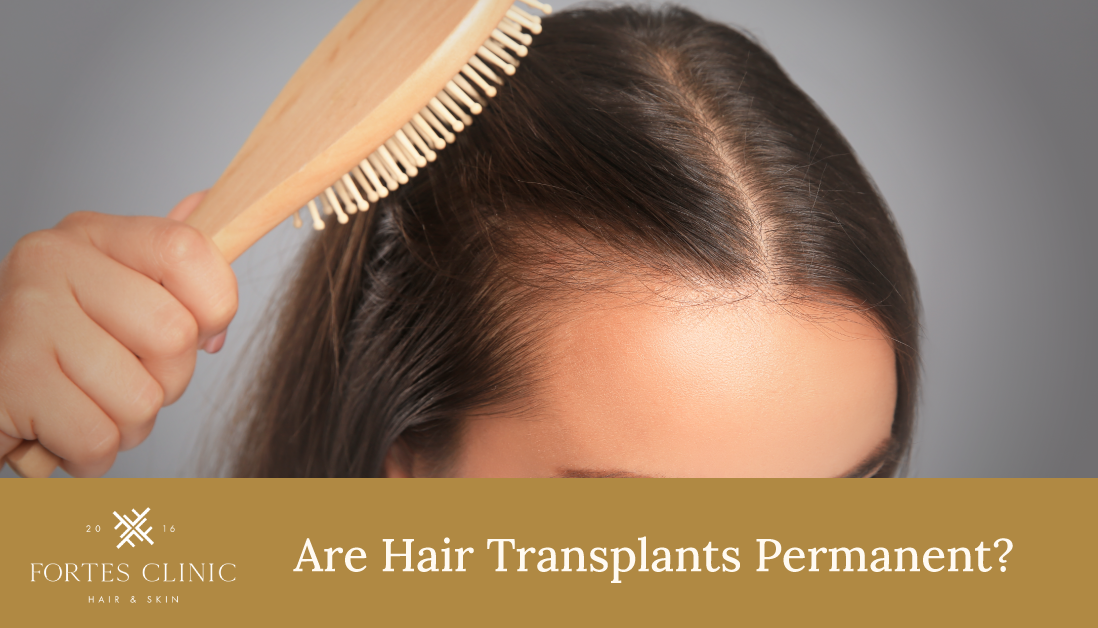Are Hair Transplants Permanent: An Introduction
Hair loss can profoundly impact an individual’s confidence and self-esteem. Whether caused by genetics, hormonal changes, or other factors, baldness and thinning hair are common concerns for many people. Fortunately, advancements in medical technology have led to the development of effective solutions, one of which is hair transplantation. However, before considering this option, it’s essential to understand “are hair transplants permanent?”
We explore this question from a doctor-led perspective, and provide a thorough understanding on how hair transplants work.
Understanding Hair Growth
Hair Growth Cycle
Hair growth is a complex process that occurs in cycles. Understanding these cycles is crucial for comprehending the permanence of hair transplants.
- Anagen Phase: This is the active growth phase of the hair follicles, during which cells in the root of the hair divide rapidly, resulting in new hair growth.
- Catagen Phase: In this transitional phase, hair growth stops, and the hair follicle shrinks.
- Telogen Phase: Also known as the resting phase, during which the old hair is shed, and the follicle remains dormant for a period before re-entering the anagen phase.
What Exactly Happens During a Hair Transplant?
Techniques of Hair Transplantation
Hair transplantation involves relocating hair follicles from a donor area, typically the back or sides of the scalp, to the recipient site (balding or thinning areas). Two primary techniques are used:
- Follicular Unit Transplantation (FUT): The FUT technique involves harvesting a strip of skin containing hair follicles from the donor area and dissecting it into individual follicular units for transplantation.
- Follicular Unit Extraction (FUE): In FUE, individual hair follicles are extracted directly from the donor area using a specialised tool and transplanted to the recipient site.
How Hair Transplants Work
During the transplantation process, the harvested hair follicles are meticulously implanted into tiny incisions made in the recipient area. These transplanted follicles then adapt to their new environment and continue to grow hair, just as they did in their original location. Over time, the transplanted hair blends seamlessly with the existing hair, providing a natural-looking result.
Factors Affecting the Permanence of Hair Transplants
Patient-Specific Factors
Several patient-specific factors can influence the permanence and success of a hair transplant:
- Age: Younger individuals tend to have better results as they typically have a more robust hair follicle reserve.
- Hair Texture: Coarse, curly hair may provide better coverage and camouflage any imperfections than fine, straight hair.
- Hair Colour: Dark hair often provides better coverage and contrast against the scalp, resulting in a more aesthetically pleasing outcome.
- Health Condition: Underlying health issues such as autoimmune disorders or uncontrolled medical conditions may affect the success of the transplant.
Surgeon Skill and Experience
The skill and experience of the surgeon performing the hair transplant are paramount to its success. A skilled surgeon will have the expertise to design a natural-looking hairline, ensure proper placement of grafts, and minimise the risk of complications such as infection or scarring. It’s crucial to research and choose a qualified surgeon who specialises in hair restoration procedures.
Type of Hair Loss
The type of hair loss being treated can also impact the permanence of the transplant. While hair transplants are highly effective for androgenetic alopecia (male and female pattern baldness), they may yield less predictable results for other types of hair loss, such as alopecia areata or scarring alopecia.
Post-Transplant Care
Proper post-transplant care is essential for ensuring the long-term success of the procedure. This includes following the surgeon’s instructions for hair care and hygiene, taking prescribed medications (such as antibiotics or hair growth stimulants), and attending follow-up visits for monitoring and adjustments.
Assessing the Long-Term Results
Expected Results vs. Reality
It’s crucial for patients to have realistic expectations about the results of a hair transplant. While significant improvement in hair density and appearance can be achieved, perfection is not guaranteed. Some patients may require multiple sessions to achieve their desired outcome, and individual results may vary.
Success Rates and Studies
Numerous studies have been conducted to evaluate the success rates and long-term outcomes of hair transplants. These studies have generally shown high patient satisfaction rates and lasting results, particularly when performed by skilled surgeons and in suitable candidates. However, it’s essential to note that success rates may vary depending on various factors, including patient characteristics and surgical techniques.
Addressing Common Concerns and Myths
Myth: Hair Transplants Cause Hair to Fall Out
Contrary to popular belief, hair transplants do not cause existing hair to fall out. The transplanted hair follicles are typically resistant to hair loss and continue to grow indefinitely in their new location. However, it’s essential to note that existing non-transplanted hair may still be susceptible to further hair loss due to underlying genetic or environmental factors.
Myth: Hair Transplants Look Unnatural
Advancements in hair transplant techniques and technology have made it possible to achieve natural-looking results. Skilfully performed hair transplants blend seamlessly with the surrounding hair, creating a soft, natural hairline and overall appearance. Factors such as proper graft placement, angle, and density contribute to the aesthetic success of the transplant.
Myth: Hair Transplants Are Only for Men
While hair loss is more commonly associated with men, women also experience hair thinning and baldness. Hair transplants are equally effective for both men and women, provided they are suitable candidates for the procedure. Women may undergo hair transplants to restore lost hair volume or to address specific areas of thinning, such as the crown or temples.
Alternatives to Hair Transplants
Medications
Hair loss medications such as minoxidil (Rogaine) and finasteride (Propecia) can help slow down hair loss and promote hair regrowth, particularly in the early stages of balding. Minoxidil is a topical solution applied directly to the scalp, while finasteride is an oral medication that works by inhibiting the conversion of testosterone to dihydrotestosterone (DHT), a hormone linked to hair loss. However, these medications may not be suitable for everyone and may require long-term use to maintain results.
Non-Surgical Procedures
Non-surgical treatments such as platelet-rich plasma (PRP) therapy and low-level laser therapy (LLLT) can stimulate hair growth and improve hair density without the need for surgery. PRP therapy involves injecting a concentrated solution of platelets derived from the patient’s blood into the scalp to promote hair growth, while LLLT uses low-level laser energy to stimulate hair follicles. These treatments may offer modest results and are often used in conjunction with hair transplants for enhanced outcomes.
Lifestyle Changes
Maintaining a healthy lifestyle can contribute to overall hair health and potentially slow down the progression of hair loss. A balanced diet rich in vitamins, minerals, and protein is essential for promoting hair growth and preventing hair thinning. Regular exercise helps improve blood circulation to the scalp, while stress management techniques such as meditation or yoga can reduce stress-related hair loss. Additionally, avoiding smoking and excessive alcohol consumption can help preserve the integrity of the hair follicles and promote overall hair health.
Are Hair Transplants Permanent: A Summary
In conclusion, hair transplants can provide a permanent solution to hair loss for many individuals, offering restored confidence and improved quality of life. By understanding the intricacies of hair growth, the hair transplant procedure, and the factors influencing its permanence, patients can make informed decisions and achieve satisfactory outcomes. It’s essential to consult with a qualified surgeon to assess candidacy and explore the most suitable treatment options for individual needs. With proper care and realistic expectations, hair transplants can indeed be a lasting solution to hair loss.
Keen to learn more about hair transplants? Reach out to our friendly team today and book your consultation.



